Moths - Study guides, Class notes & Summaries
Looking for the best study guides, study notes and summaries about Moths? On this page you'll find 619 study documents about Moths.
Page 3 out of 619 results
Sort by

-
Biology 1108 Unit 1 EXAM Questions and Answers 100% Pass
- Exam (elaborations) • 28 pages • 2024
-
- $12.49
- + learn more
Biology 1108 Unit 1 EXAM Questions and Answers 100% Pass The term "n" refers to the size of a population, that is, the number of individuals in that population. In general, in a sample of n individuals, the frequency of an allele is: A)the number of occurrences of the allele. B)the number of occurrences of the allele divided by n. C)the actual value of n D)the number of occurrences of the allele divided by twice the number of individuals in the sample (2n). E)twice the number of occur...

-
Biobeyond Unit 3 Birds and the Moths Reading Guide | 100% Correct Answers | Verified | Latest 2024 Version
- Exam (elaborations) • 2 pages • 2024
-
- $7.99
- + learn more
what is the peppered moth an example of - camouflage what does camouflage do for an organism? - allows it to blend into natural environment and hide from predators what happened to tree color in industrial revolution? - got darker due to soot what happened to peppered moths when trees were darker? - less camouflage, got eaten more, more black moths reproduced (carbonaria) increase in factories impact on carbonaria - increase increase in factories impact on typica - decrease increase in f...

-
Biology 1108 Final Exam Quiz Questions with 100% pass
- Exam (elaborations) • 15 pages • 2024
- Available in package deal
-
- $12.49
- + learn more
Biology 1108 Final Exam Quiz Questions with 100% pass The term "n" refers to the size of a population, that is, the number of individuals in that population. In general, in a sample of n individuals, the frequency of an allele is: - Correct Answer ️️ -the number of occurrences of the allele divided by twice the number of individuals in the sample (2n) If a population is not in Hardy-Weinberg equilibrium, we can conclude that: - Correct Answer ️️ -evolution has occurred because on...
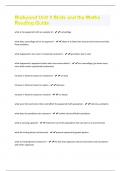
-
Biobyond Unit 3 Birds and the Moths Reading Guide Rated 100% Correct!!
- Exam (elaborations) • 2 pages • 2023
- Available in package deal
-
- $2.99
- + learn more
what is the peppered moth an example of - camouflage what does camouflage do for an organism? - allows it to blend into natural environment and hide from predators what happened to tree color in industrial revolution? - got darker due to soot what happened to peppered moths when trees were darker? - less camouflage, got eaten more, more black moths reproduced (carbonaria) increase in factories impact on carbonaria - increase increase in factories impact on typica - decrease increase in f...
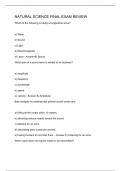
-
NATURAL SCIENCE FINAL EXAM REVIEW
- Exam (elaborations) • 13 pages • 2024
-
- $12.59
- + learn more
Which of the following is totally a longitudinal wave? a) Water b) Sound c) Light d) Electromagnetic e) Laser - Answer-B) Sound Which part of a sound wave is related to its loudness? a) amplitude b) frequency c) wavelength d) speed e) velocity - Answer-A) Amplitude Bats navigate by emitting high pitched sound waves and a) killing all the moths within 10 meters. b) attracting various insects toward the sound. c) listening for an echo. d)...

-
Biology 1108 Unit 1 EXAM Questions and Answers 100% Pass
- Exam (elaborations) • 28 pages • 2024
- Available in package deal
-
- $13.49
- + learn more
Biology 1108 Unit 1 EXAM Questions and Answers 100% Pass The term "n" refers to the size of a population, that is, the number of individuals in that population. In general, in a sample of n individuals, the frequency of an allele is: A)the number of occurrences of the allele. B)the number of occurrences of the allele divided by n. C)the actual value of n D)the number of occurrences of the allele divided by twice the number of individuals in the sample (2n). E)twice the number of occur...
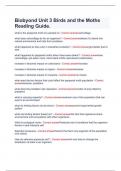
-
Biobyond Unit 3 Birds and the Moths Reading Guide
- Exam (elaborations) • 2 pages • 2024
-
- $7.99
- + learn more
Biobyond Unit 3 Birds and the Moths Reading GuideBiobyond Unit 3 Birds and the Moths Reading GuideBiobyond Unit 3 Birds and the Moths Reading GuideBiobyond Unit 3 Birds and the Moths Reading Guide
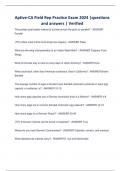
-
Aptive-CA Field Rep Practice Exam 2024 |questions and answers | Verified
- Exam (elaborations) • 25 pages • 2024
-
- $12.89
- + learn more
The powder post beetle makes its tunnels across the grain or parallel? - ANSWER Parallel (T/F) Indian meal moths hind wings are coppery - ANSWER False What are the wing characteristics of an Indian Meal Moth? - ANSWER Coppery Front Wings
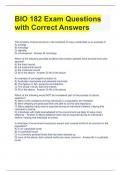
-
BIO 182 Exam Questions with Correct Answers
- Exam (elaborations) • 51 pages • 2023
- Available in package deal
-
- $11.49
- + learn more
BIO 182 Exam Questions with Correct Answers The similarity of bone structure in the forelimbs of many vertebrates is an example of A) analogy B) homology C) digitality D) convergence - Answer-B) homology Which of the following provides evidence that modern species have evolved from prior species? A) the fossil record B) the anatomical record C) the molecular record D) All of the above - Answer-D) All of the above An example of convergent evolution is: A) Australian marsupi...
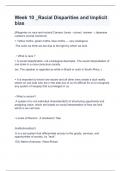
-
Week 10 _Racial Disparities and Implicit bias Chamberlain college school of Nursing Question and answers rated A+ 2024
- Exam (elaborations) • 13 pages • 2024
- Available in package deal
-
- $13.99
- + learn more
Week 10 _Racial Disparities and Implicit bias Chamberlain college school of Nursing Question and answers rated A+ 2024 Week 10 _Racial Disparities and Implicit bias [Allegories on race and racism] Camara Jones - correct answer • Japanese Lanterns (social construct) = Yellow moths, green moths, blue moths --- very analogous -The color we think we are due to the light by which we look. . • What is race ? = A social classification, not a biological descriptor. The social interpret...

That summary you just bought made someone very happy. Also get paid weekly? Sell your study resources on Stuvia! Discover all about earning on Stuvia


